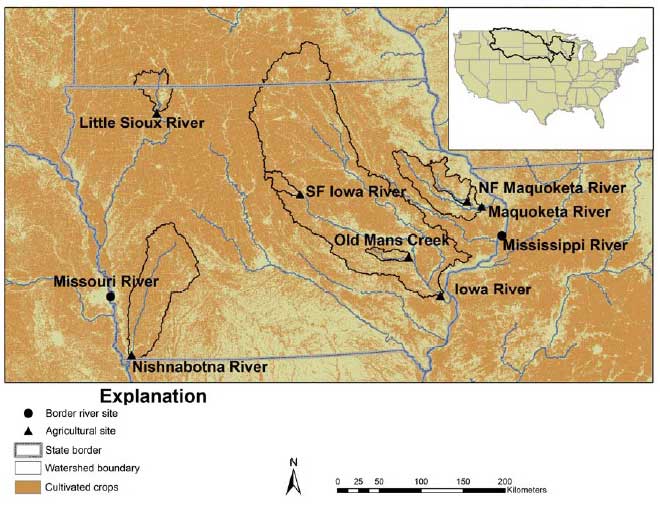Insecticides that behave like nicotine, known as neonicotinoids, became popular in the late 1990s as replacements for more toxic products. They have been effective but like all products there is concern about ongoing environmental effects. The U.S. Environmental Protection Agency has classified all neonicotinoids as safe for humans.
A recent United States Geological Survey study found neonicotinoids in streams throughout the Midwest. Because of their effectiveness and lower ecological footprint, neonics have dramatically increased over the last decade across the United States, particularly in the Midwest. The use of clothianidin, one of the chemicals studied, almost doubled on corn in Iowa between 2011 and 2013. They dissolve quickly in water but do not break down quickly in the environment, so they can be transported in runoff from fields to nearby surface water and groundwater bodies.
In all, nine rivers and streams, including the Mississippi and Missouri Rivers, were included in the study. The rivers studied drain most of Iowa, and parts of Minnesota, Montana, Nebraska, North Dakota, South Dakota, and Wisconsin. These states have the highest use of neonicotinoid insecticides in the Nation, and the chemicals were found in all nine rivers and streams.

These are locations of sites in Iowa sampled for neonicotinoids in 2013. Watersheds for the Mississippi River and Missouri River sites are shown in the inset. Credit: USGS
Of the three most often found chemicals, clothianidin was the most commonly detected, showing up in 75 percent of the sites and at the highest concentration. Thiamethoxam was found at 47 percent of the sites, and imidacloprid was found at 23 percent. Two, acetamiprid and dinotefuran, were only found once, and the sixth, thiacloprid, was never detected.
Instead of being sprayed on growing or full-grown crops, neonicotinoids can be applied to the seed before planting. The use of treated seeds in the United States has increased to the point where most corn and soybeans planted in the United States have a seed treatment (i.e., coating), many of which include neonicotinoid insecticides.
"We noticed higher levels of these insecticides after rain storms during crop planting, which is similar to the spring flushing of herbicides that has been documented in Midwestern U.S. rivers and streams," said USGS scientist Michelle Hladick, the report's lead author. "In fact, the insecticides also were detected prior to their first use during the growing season, which indicates that they can persist from applications in prior years."
One of the chemicals, imidacloprid, is known to be toxic to aquatic organisms at 10-100 nanograms per liter if the aquatic organisms are exposed to it for an extended period of time. Clothianidin and thiamethoxam behave similarly to imidacloprid, and are therefore anticipated to have similar effect levels. Maximum concentrations of clothianidin, thiamethoxam and imidacloprid measured in this study were 257, 185, and 42.7 nanograms per liter, respectively.






Comments